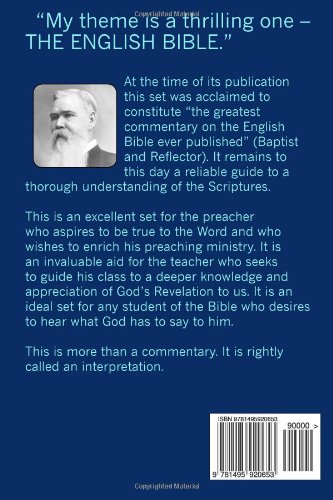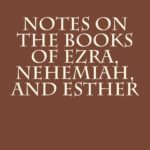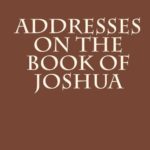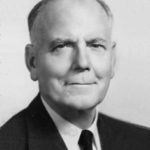Description
An Interpretation of the English Bible Volume II
EXODUS
And
LEVITICUS
by
B. H. CARROLL
CONTENTS
Contents
I INTRODUCTORY STUDIES: THE GEOGRAPHY OF EXODUS 5
II INTRODUCTORY STUDIES: MATERIAL FOR A HISTORY OF MOSES 14
III A REVIEW AND A PROLOGUE Exodus 1:1-14. 23
IV BIRTH AND PREPARATION OF MOSES Exodus 1:15 to 2:22 36
V MOSES AT THE BURNING BUSH Exodus 2:23 to 5:14. 51
VI THE TEN PLAGUES, OR THE GREAT DUEL. 63
VII THE TEN PLAGUES, OR THE GREAT DUEL (Continued) 75
VIII THE INSTITUTION OF THE PASSOVER Exodus 12-13 85
IX THE MARCH OUT OF EGYPT, THE PASSAGE OF THE RED SEA, AND THE TRIUMPHAL SONG Exodus 14:1 to 15:21. 95
X FROM THE RED SEA TO SINAI Exodus 15:22 to 16. 105
XI FROM THE RED SEA TO SINAI (Continued) Exodus 17-18 113
XII THE COVENANT AT SINAI – ITS GENERAL FEATURES Exodus 19:1 to 24:11 126
XIII THE COVENANT AT SINAI (Continued) 140
XIV THE DECALOGUE – THE FIRST AND SECOND COMMANDMENTS 148
XV THE DECALOGUE – THIRD COMMANDMENT. 160
XVI THE DECALOGUE – FOURTH COMMANDMENT. 170
XVII THE DECALOGUE – THE FIFTH COMMANDMENT. 184
XVIII THE DECALOGUE – THE SIXTH COMMANDMENT. 195
XIX THE DECALOGUE – THE SEVENTH COMMANDMENT 210
XX THE DECALOGUE – THE EIGHTH COMMANDMENT. 225
XXI THE DECALOGUE – THE NINTH COMMANDMENT. 238
XXII THE DECALOGUE – THE TENTH COMMANDMENT. 248
XXIII THE LAW OF THE ALTAR. 261
XXIV GOD AND THE STATE, THE STATE AND THE CITIZEN, THE PROMISES, AND THE RATIFICATION OF THE COVENANT. 273
XXV THE FEAST OF THE COVENANT, THE ASCENT OF MOSES AND JOSHUA INTO THE MOUNTAIN, THE BREACH OF THE COVENANT, THE COVENANT RESTORED BUT MODIFIED.. 285
XXVI THE BREACH OF THE COVENANT (Continued) AND ITS RENEWAL 301
XXVII THE TABERNACLE. 309
XXVIII THE TABERNACLE (Continued) 322
THE BOOK OF LEVITICUS. 333
I PREPARATORY STUDIES – THE SINAITIC COVENANT. 333
II INTRODUCTORY STUDIES – HISTORICAL. 337
III OFFERINGS Leviticus 1-7. 348
IV CONSECRATION OF AARON AND HIS SONS. 361
V THE GREAT DAY OF ATONEMENT. 371
VI THE DISTINCTION BETWEEN CLEAN AND UNCLEAN. 384
VII THE LAW OF HOLINESS. 397
VIII THE TIMES OF COMING BEFORE THE LORD.. 408
IX THE LAND SABBATH AND THE JUBILEE SABBATH.. 418
X THE LAMP OF GOD, BREAD OF THE PRESENCE, DEATH OF THE BLASPHEMER, PENALTIES FOR MURDER, AND GREAT LAW PRINCIPLE 431
XI THE PROMISES AND THREATENINGS OF THE COVENANT 440
XII REGULATION OF VOLUNTARY VOWS. 446
I INTRODUCTORY STUDIES: THE GEOGRAPHY OF EXODUS
Focus in your minds the geography of Egypt and the Sinaitic Peninsula. Those who have the Rand-McNally Bible Atlas can study the history and geography together. If you were in a balloon over Egypt twenty miles in the air, you would see what looks like a green ribbon in the desert, which represents the Nile and its narrow boundaries, all of Egypt that has ever been good. Out of 115,000 square miles in Egypt only 9,600 are habitable, and only about 5,600 are made up of arable land.
The lower part of Egypt is called the Delta, from the Greek letter which answers to our “D”, caused by the division of the Nile into several mouths. All of that Delta country is very rich from alluvial deposits made by the overflows of the Nile. The part on the east near the Arabian Peninsula was Goshen, where the children of Israel settled. The ancient capital, Memphis, was situated above the first fork, a famous city. Later, the capital was shifted to Thebes.
Soon after the dispersion of the nations at the Tower of Babel, the sons of Ham occupied Egypt, the country given to them. Without the Nile there would be no Egypt. It is only a short distance from either bank to an impassable desert. Ancient history has to do with Egypt from the city of Thebes to the mouth of the Nile. It knows nothing of upper Egypt. The White Nile rises in the heart of Central Africa, only recently discovered by Livingstone, Stanley, and others. Just now a railroad runs up the Nile to Khartourn, and from there to the heart of Africa. From Cape Town, the most southern point of Africa, a road starts and runs up. In a short time that road will be completed, and Northern and Southern Africa will be united by rail. That was the great project of Cecil Rhodes, the Cape-to-Cairo railroad. The present capital of Egypt is Cairo.
The first important event in this ancient history is the building of the Great Pyramid of Cheops. We know very little about the building of these pyramids, but they go back long before the time of Abraham, nearly to Nimrod. This pyramid is the most imposing structure of its kind in the world. It has a great square base, going up in terraces, so that a man standing on one stone can just reach the one above him. There are people there who hire out to pull visitors up from one stone to another. The pyramids constituted one of the Seven Wonders of the Ancient World, and constitute one of the wonders of the world to this day. They were supposed to be built as tombs, based upon the fact that the first time history became acquainted with them, there were in them the mummies of distinguished kings. From one of these great pyramids has been brought the very Pharaoh who received Joseph, and it is said in unwrapping that mummy they found a grain of wheat that had somehow got into the linen, and that when that grain of wheat was planted it grew.
That building is said to be “oriented,” because it was built exactly with the-compass and with reference to the east. If you ever join the Masons they will tell you a good deal about that. There is a hole in the pyramid, and once every two or three thousand years a star gets to a position in which it shines right down that hole to the very bottom. This indicates that those ancient peoples were marvelously well acquainted with astronomy. They could not have calculated the revolution of the heavenly bodies in such vast cycles of time and built with reference to it, if they had not been.
This Great Pyramid must have been built by slave labor only, and at a great cost of life; all other structures of Egypt are of the same kind, very massive in style, with very little architectural beauty. Near the pyramids is another wonder of the world, the Sphinx, a winged lion with a man’s head. That has been largely covered with sand in the thousands of years of time, but a considerable part of it shows above the ground now.
Who built these pyramids nobody knows. You can only get glimpses of that far-off time from certain inscriptions, the deciphering of which is only a learned guess. There has been a vast deal discovered in modern times in the way of archeology bearing upon Bible history. Inscriptions have been deciphered, the names of kings and dynasties discovered, showing that the oldest nation in history is Egypt, and that it had a high grade of civilization of its kind.
Two other things are necessary before taking up another feature of the discussion. One of these old kings fell upon a new project, now being utilized on the western plains of the United States to provide storage for the surplus of water during the overflows. He had an immense excavation made, incredibly great, and canals dug that led from the Nile to that immense reservoir, and when the overflow would come it would be filled with water. Then he had canals cut connecting the different branches, or mouths, of the Nile, traversing all the country for the purpose of irrigation. It was done by slave labor. In order to get the water out of the reservoir, they used big pumps worked by hand, having an endless chain with buckets upon it which worked like an undershot wheel. The ancient Egyptians had a wonderful knowledge of mathematics in all its departments. If you want to read a thrilling book that will give you some idea of the degree of knowledge attained by the ancient Egyptians, read Tom Moore’s Epicurean, concerning an Anthenian youth who went to Egypt and was initiated into all the mysteries of the knowledge that they had there. It is written as a novel, but it is very true to nature. When I was a student of ancient history I had to read that book. G. M. Ebers has several books on ancient Egypt.
The character of the country is generally the same now as it was when the Tower of Babel was built. There are no changes, not even a railroad can change it. At one time the Egyptian empire extended through the Arabian Peninsula as far as the Holy Land and to the Euphrates. That was its greatest extent. A great many of the manners and customs of the Egyptians are indicated in the book of Genesis, which tells us how Joseph got there and how he was brought in touch with the people.
In the time of Moses there existed a fact not brought out until recently, viz.: a wall extended across the isthmus from the Mediterranean to the Red Sea. That wall explains why Moses, instead of going the middle way to the Holy Land, turned and went south, turning the upper end of that wall. All along it were towers held by the regular army of Egypt. The children of Israel wandered for thirty-eight years in the Wilderness; thirty-eight years of silence with only a few stations given in one of the books of the Pentateuch. The peninsula of Sinai is a plain of white sand. The northern part is called the wilderness of Paran in the Old Testament, “the great and terrible wilderness.” Another part of the peninsula of Arabia is called the Negeb, or “South Country.” In that country Isaac and Abraham, with their herds, dwelt. And there is Kadesh-barnea, the nearest point that the Israelites reached in going that way to the Promised Land. Another prominent feature of that country is the Arabah, the supposed ancient bed of the Jordan River, which rises away up in Lebanon, comes down and flows into the Dead Sea. The Dead Sea is so much lower than the Mediterranean, the Mediterranean would flow into it if a canal were cut between them. It is the deepest hole in the ground we know anything about. From the Dead Sea to a little arm of the Red Sea is that broad ravine, called the Arabah. At a point on the Arabah, near Mount Hor, the elevation is 500 feet above the Dead Sea, and from Mount Hor south it slopes the other way. It has been reasonably conjectured that originally the Jordan River entered into this lower sea, and this ravine is nothing but a continuation of the valley of the Jordan. But it is now filled up, so that it is far above the Dead Sea.
Now let us get all the wildernesses in our minds. From the end of that wall is a narrow strip along the beach of the Red Sea, the way Moses came down. It is called “The Wilderness of Sin,” the upper part, the “Wilderness of Etham.” Near the upper part of the arm of the Red Sea is the “Wilderness of Zin.” So there are five of these wildernesses, via.: Sin, Zin, Etham, Shur, and Paran.
Notice the mountain ranges. Moses passed between a mountain range and the sea, coming down by a beach. In the lower part, the mountains get very high, and it is called the Sinaitic Peninsula. Near Mount Sinai is a level plain about 2,200 yards long, upon which the children of Israel camped. The mountain rises precipitously out of the plain so that one can step right up to it and touch it. It rises to an immense height, and looking down from the top one could see the tents of the Israelites spread out like snowflakes. You ought to familiarize yourself with the Sinaitic Peninsula before Moses got there, its mountains, deserts, and inhabitants; the Amalekites lived there. Moses fought a battle with them before he reached Mount Sinai, and two others before he reached Kadesh-barnea. They were the ancient Canaanitish people and the bitter foes of the Israelites, and were doomed by the curse of Moses to utter extinction. Still they were not destroyed until the time of Saul and David.
Look at this valley, the Arabah. In the east are a mountain range and Mount Seir. Seir was the father of the Horitee, or “cave-dwellers.” Today are marvelous caves in that section hollowed out from a time beyond the memory of man. These Horites were overcome by the descendants of Esau, and then Esau occupied that country. Hence all this country is called Edom, clear to where it touches Moab. You will find many references to Edom; it means “red.” The mountains were of red granite. The descendants of Esau were unfriendly to the descendants of Jacob and refused to allow them to pass through their country to the Promised Land. So they had to go south and cross the desert. That place Kadesh-barnea, of which so much is said in Exodus, Numbers, and Deuteronomy, was their last stopping place before they reached the borders of the Promised Land. When they returned to Kadesh-barnea they had wandered thirty-eight years. There is a book on Kadesh-barnea, by H. Clay Trumbull, in which he tells where the true Kadesh-barnea is; the commentaries had previously put it in an entirely different place. Dr. Sampey, of the Southern Baptist Theological Seminary, was so much impressed with the book that when he went to the Holy Land he went to Kadesh-barnea, and he says that the place is Just as represented in Trumbull’s book. All of Exodus, Leviticus, Numbers, and Deuteronomy, except Just a little, takes place in that country. The Israelites stopped at Mount Sinai, having reached it in two months. They received the Law, built the tabernacle and the Levitical order of worship was prescribed. Mount Sinai has much to do with the history of the people. Stanley’s Jewish Church, in three volumes, is very fine on the Sinaitic history and peninsula. So, study it with Kadesh-barnea. Exodus commences in the land of Goshen. Moses, the author of the Pentateuch, lived not so very long after the time of Job. I believe that Moses wrote the book of Job. When he fled into the wilderness he touched the Job country.
QUESTIONS
1. What countries have to do with Exodus?
2. Give a balloon view of Egypt.
3. How large, how much habitable, and how much arable?
4. What is the lower part of Egypt called and why?
5. What of its fertility and why?
6. Where did the children of Israel settle?
7. What were the capitals and where?
8. Who first settled Egypt and when?
9. With what part does ancient history have to do?
10 What were the boundaries of Egypt?
11. Where is the Blue Nile? The White Nile?
12. What modern improvement in this section?
13. What was the Cecil Rhodes project?
14. What was the first important event in this ancient history?
15. What was the date of pyramid building?
16. What was the purpose of these buildings and the evidence?
17. How do they rank with the other buildings of the world?
18. What is meant by “oriented” as referring to the Pyramid of Cheops?
19. What singular thing indicates their acquaintance with astronomy?
20. How were these pyramids built?
21. What other wonder of the world are near these pyramids?
22. Who built these pyramids?
23. What was our means of information of this time?
24. What of the antiquity of Egypt and its civilization?
25. How did they utilize the surplus water from the overflow of the Nile?
26. What science did they develop above others of their day?
27. What book on the knowledge of the Egyptians commended?
28. What of the character of the country now?
29. What was its greatest extent?
30. What book of the Bible tells us much of the manners and customs of the Egyptians?
31. Why did not Moses go the short way to the Holy Land?
32. What the nature of the Sinaitic plain?
33. What is the Arabah?
34. How many and what wildernesses in this peninsula?
35. Who were the inhabitants here and when destroyed?
36. Who were the Horites and who overcame them?
37. What was the attitude of the descendants of Esau toward Israel and why?
38. What book on Kadesh-bamea commended?
39. What one on the Sinatic history and peninsula?
40. Where does Exodus begin?
41. What patriarch was almost contemporary with Moses?
42. Where did Moses go when he fled from Egypt?






Reviews
There are no reviews yet.